Jeff Hedgecock – Historic Arms &
Armor, California
 1. How long have you been doing armor, for fun
or professionally? 1. How long have you been doing armor, for fun
or professionally?
I started making armour for fun 15 years ago in 1986. I began my career as a
professional armourer just one year later in 1987.
2. Do you have an area or period of historical armor you
specialize in creating?
I have always been open to commissions for armour from any period or area of
manufacture; I’ve done ancient Greek all the way to 19th century English royal
horseguard armour. Generally speaking, people come to me for 15th century armour, though I
have made a fair amount of 14th and 16th century pieces. I feel most comfortable with 15th
century pieces because this is where I have concentrated my research.
3. Do you have a particular favorite piece or harness that you most enjoy
constructing or working on?
Sallets have always held my interest, as they are very complex sculpturally. There are
many different types of sallets and are very challenging to interpret correctly. Leg
harness for use on horse is also of special interest to me, being an avid mounted
combatant.
4. Where did you first acquire an interest in historical armor and when did you
make the realization you had a real aptitude for doing it?
My interest originally began when I did a report on Arms and Armour in 7th grade. I
never expected then that I would make my living as an armourer. Producing armour is a constant learning
experience, as is running a business. When you do this as your sole livelihood, the two
skills are intertwined. Because of this, I believe there are two realizations that happen
when you embark on an armouring career; one happens when you start producing sellable
pieces, another when you reach a point where you believe you can make a viable living at
it. I developed my critical eye for line and form while pursuing my art degree at UC San
Diego, which I believe was the beginning of my aptitude development. I began making armour
a year after graduation, but don’t really feel that I matured as an armourer until 7
or 8 years ago. I realized early on that I had an aptitude for armouring due to my art and
creative background and education. I felt that even though my early efforts were very
clumsy, if I persisted and always worked to better my skills I would certainly produce
very competent work.
5. Can you identify any major breakthrough that transformed your own study of
armor making?
A light went on my head several years ago- “oh wow, you can smush steel around
just like clay, it only takes longer and you can’t use your fingers.” From then
on, my approach to shaping has been much more successful. Steel is a very plastic medium
and should be treated as such; like clay only much harder. I’ve done a fair amount of
clay sculpting work with the entertainment projects we’ve taken on, so it gives me an
interesting view of sheet steel as sculptural media. This new approach combined with the
use of hot work gave me a new perspective and taught me that the sculptural possibilities
of my techniques are almost limitless.
6. What was one of the hardest skills to learn in armoring?
Achieving an even finish with modern grinding and buffing machinery is always
difficult. So much of what holds our eye to historical armour is the glowing steely shine,
which we’ve come to expect after having seen so many pictures of museum pieces that
have been lovingly conserved by hand, then carefully photographed to display their
three-dimensionality on a two dimensional page. This is very difficult to achieve
economically. I’m always experimenting and refining my techniques.
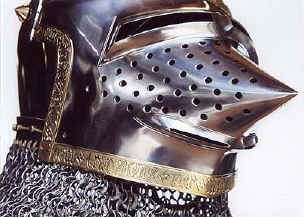 7. What is your favorite historical
period to wear? 7. What is your favorite historical
period to wear?
Because of my involvement as founder of the reenactment group The Red Company-1471
it’s probably not a surprise that I’m a big fan of the 1460¹s and 1470¹s. The
clothes are interesting, the armour quite sophisticated and beautiful, and the concept of
the “knight in shining armour” was at its zenith. I also have a fascination with
the Napoleonic Hussar. Their uniforms were striking and impressive and I hope to acquire
one sometime soon. I have the horse already...
8. Is there a piece of work you are most proud of?
There are several pieces I’ve made that I’m fond of and really didn’t
want to let go to the client. What stands out in my mind are usually the recent pieces,
one of which is a Bascinet based primarily on the Churburg #13. I raised the skull from
flat, and raised the visor from a cone shape on which I forge welded the seam (I believe
this could be a medieval technique). I studied the brass trim and hand engraved it as was
done on the original. The client and I were both extremely happy with the piece. I’ve
also recently made a gothic style chamfron for my horse. She looks quite smashing in it!
9. Is there some major accomplishment in armoring you still hope to achieve?
I would very much like to produce a full harness for myself. It’s very difficult
to find time in a demanding schedule to produce pieces for oneself. I designed a 1460¹s
Milanese harness about 7 years ago which I planned to build all at once, but so far the
only thing I’ve built are the arms. It would also be quite interesting to make a
replica of Henry VIIIs silvered and engraved armour. I possess a very detailed monograph
on the armour, which provides enough information to construct the piece, it’s just a
matter of finding a client who would like to order the harness. Also, several years ago a
client requested a quote for Robert Dudley’s armour, but did not end up ordering.
Making that Earl of Leicester’s armour would indeed be an achievement for me.
10. Do you have a particular favorite style of harness or helmet of your own that you
most favor?
I’ve always been interested in mid to late 15th century armour, what most people
refer to as “gothic”. Stylistically I’m drawn to Italian armour,
particularly export styles and those made by Italians working in Flanders and Burgundy.
I’m very fond of Flemish style helmets of the mid to late 15th century.
11. If so, what makes it a favorite?
They have the sculptural qualities of Italian armour, but some of the detailing of the
German armourers. Very pleasing.
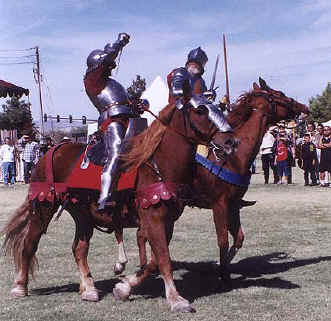 12. How active are you in training
or practicing in your armors? 12. How active are you in training
or practicing in your armors?
Currently I practice mounted or unmounted combat about once a month on average. A few
years ago, I was very active in foot combat in one of the clubs, but have since chosen to
pursue primarily mounted combat endeavors, which that club does not practice. Mounted
combat is problematic, in that you must implicitly trust the people you practice with
which limits your possible participants. The horses must be very well trained and the
whole endeavor is very complex, slow and time consuming. It is my belief that most
“knights” were horsemen first and combatants second. In the late 15th century
(my period of specialization) men did not go to battle or tournament every week, so I
don’t believe they may have practiced as much as we might speculate. It seems likely
that the 15th century knight may have spent more time training his horse and riding than
practicing his swordsmanship. I follow this pattern. The few people who do
un-choreographed mounted combat should confirm that.
13. How would you say today’s custom armor industry compares to that of say 10 or
15 years ago?
Thankfully, everyone is much more sophisticated now than then, armourers and clients
alike. Clients who know historical armour expect it to look right and function properly.
There has been a distinct divergence of concentration among armourers working today; some
make “sporting” armour for the large combat organizations, with a very small
minority focusing on true “replicas”. In general, quality has increased, even
among the sporting armourers, and the days of spun top helmets are largely over. There
will probably always be a need for “sporting” armour, but I am pleased that that
field is rather separate from historical armouring now.
14. Where do you see the custom armor industry in 10 years? What developments do
you anticipate, or would you like to see?
I would like to see a trend develop that would enable armourers with existing shops to
take on journeyman employees in an effort to handle the increasing demand for high quality
product. As in any business, the most difficult challenge is finding good help and trained
armourers are not plentiful. There is a huge demand for historical armour and simply not
enough armourers to produce it. Most shops are only one armourer working by himself, and
there is a distinct limit to how much one person can make. There is always a slew of
enthusiastic newcomers out there who have stars in their eyes and think they can learn
armouring in a few weeks. They say “teach me to make armour and I’ll help you in
your shop”, and then they are disappointed that they’re not able to produce high
Gothic plate within a month of starting. Armourers need to connect with people who will
make the commitment to learn the craft as a career, not just a hobby. This hopefully will
keep the craft alive and allow more clients to acquire the pieces they’re thirsty
for.
 15. Is there a major demographic that makes up
your major customers? That is, do you produce more items for private collections,
the film industry, re-enactors, performers, costume ware? 15. Is there a major demographic that makes up
your major customers? That is, do you produce more items for private collections,
the film industry, re-enactors, performers, costume ware?
Our steadiest business comes from reenactors and collectors. Entertainment industry
contracts are very lucrative and creatively interesting, but deadlines are often
unrealistic. Most entertainment clients expect you to work exclusively on their job during
its duration, which is problematic where concurrent work is concerned. We also provide an increasing number of items to
historic sites around the world. The replica clothing work of my wife, Gwen Nowrick,
combined with our other Historic Enterprises endeavors is really key here. With our
diverse products offerings, historic sites are coming to us more and more.
16. How many expert armorers of top notch artistry and accuracy would you say there are
in North America or Europe at present?
Probably less than half a dozen in North America, perhaps a similar number in Europe,
though I am less familiar with that market.
17. What are some of your feelings about the recent growth of the mass off-shelf market
in armor (aimed at the general public) as opposed to the professional custom-maker’s
individualized work?
The two products are really quite different and care should be taken in any comparisons.
There are specific limitations to what can be accomplished in a mass production situation.
The same level of quality should not necessarily be expected and historic accuracy is
often sacrificed because the manufacturers are not as educated as custom armourers. Of
course production armour usually costs less and is more readily available. There are
trade-offs with both types of armour –custom armour is usually better quality and
more historically accurate, but more expensive and must be ordered, not purchased off the
rack. Mass-produced armour is usually less expensive, more available, often thinner than
is needed for combat, and often the manufacturers will make compromises in finish, detail
and historical accuracy for ease of production.
18. What changes have you seen in interest in armor in recent years? Do you see more or
less knowledge on their part of clients in what they’re looking for?
I feel clients are better at educating themselves and are in some cases more realistic in
their expectations of armour performance. As more people realize that armour is not
indestructible and wasn’t considered such by our ancestors, I think it will promote a
more thorough and realistic understanding of what should be expected from armour replicas
and the people who create them.
19. Do you think historically accuracy is becoming more appreciated among those looking
for reproduction armor?
Definitely, though I’m not sure people really consciously understand the
intricacies of what makes any given reproduction “historically accurate”. Many
finer aspects of shaping or detailing are not fully recognized by people who want accurate
replicas. They know when something is right, but they might not know specifically why.
Let’s face it, most people who purchase armour are not as critical as the armourers
themselves, so it’s up to the armourer to stretch his abilities and critical eye, to
capture the qualities of the original piece and impart them to the replica.
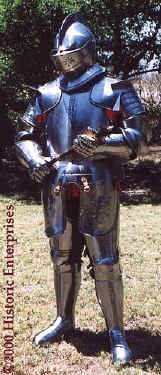 20. What changes if any have you
noted in what people are doing with their reproduction armor nowadays? Are they having it
made for different reasons than in the recent years? 20. What changes if any have you
noted in what people are doing with their reproduction armor nowadays? Are they having it
made for different reasons than in the recent years?
I’d say things have stayed pretty consistent. There is largely the same proportion of
people who wear armour, fight in it, or just decorate their home with it.
21. Can you offer any thoughts on the main differences between Milanese and Gothic
armors in terms of their how their design and fit could have historically affected the
wearer’s fighting method?
To refer to “Milanese” and “Gothic” armour is to be perhaps a
little too general. One should compare specific individual armours, as stylistic
characteristics cross over between what we think of as “Milanese” or
“Gothic”. In the very general sense, armours with larger pauldrons such as might
be generally accepted as “Milanese” might affect the arm movement differently
than armours thought of as “Gothic”, which seem to have predominantly smaller
shoulder defenses. The best method to compare any two styles of armour would be to
reconstruct both harnesses and have the same person perform the same actions in them. Only
an evaluation of this type has real significant value.
22. Are there any observations you could offer on the effects real swords had on
historical armor? Any issues you would care to address on that matter?
It has long been my belief that swords are not an effective cutting weapon against armour.
My practical experience in fighting in harness bears this out. It is possible to defeat an
armoured opponent with a sword thrust, but this is a technique that is more difficult to
learn, master and execute. Fiore de Liberi’s Flos Duellatorum is an excellent
resource for information on what techniques are effective in sword versus full armour.
There is a reason combatants used maces, warhammers and axes when fighting fully armoured
opponents –swords were simply not very effective against plate armour. By the time
full plate harness had fully developed, swords as field weapons had become largely fashion
accessories or tools to use against less protected opponents. The best weapon to defeat a
fully armoured combatant was designed to puncture, crush or shatter, not to cut. It is
important to note that the type of steel used in armour makes a large difference in its
effectiveness and durability against any weapon. Most replica armour today is of mild
steel, while the historical counterparts were likely made of higher carbon, heat treated,
“tougher” material. This also affects the wearer’s technique, as armour
made of tougher steel can be thinner to achieve the same strength, thus lightening it.
23. What advice do you have to offer the young fledging novice hoping to begin learning
the craft of historical armor reproduction for fun?
In for a penny, in for a pound. To truly learn the craft of “historical armour
reproduction”, you must make a commitment to the art, and I’m not sure this can
be done for “fun”. It is a lifelong learning process which seems best done in a
career situation. It’s very difficult to learn enough about metal shaping when
pursuing it as a hobby to produce accurate armour. It’s another matter entirely to
learn about armour in its historical context and to be able to apply metalworking
techniques to fabricating pieces of armour. If you’re going to do it, realize
it’s not easy, fast or fun. Don’t try to “dabble”; you’ll only
frustrate yourself.
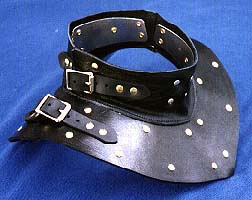 24. What special projects do you have on the horizon? 24. What special projects do you have on the horizon?
I am currently producing armour for several Wars of the Roses reenactors on the east
coast and have several full armours on the books for next year. Cabrillo National Monument
in San Diego has awarded us a contract to produce arms, armour, clothing and accessories
for the reinstallation of their museum exhibit in June 2002. This new exhibit will be on
display for at least the next 30 years. We are also working on a line of helmets and
armour pieces for production in the new year. We expect to have in-stock pieces for 15th
century reenactors and the growing tournament company groups.
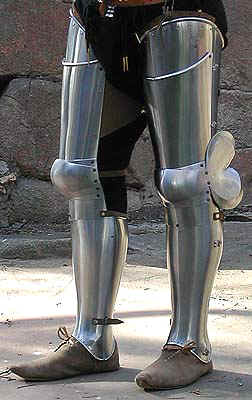 25. Finally, what advice can you
offer for the beginning enthusiast wanting to get into Late Medieval armored combat
training for the first time? (what items are most important to acquire first, how
much should they expect to spend, and how long should they anticipate in getting a
harness)? 25. Finally, what advice can you
offer for the beginning enthusiast wanting to get into Late Medieval armored combat
training for the first time? (what items are most important to acquire first, how
much should they expect to spend, and how long should they anticipate in getting a
harness)?
Prepare yourself to spend time and money. I encourage anyone to consider this activity
like any other serious avocation. Appearance and safety are two primary concerns when
practicing European martial arts, because not only is armour practical, but it’s
aesthetic too. Anyone can strap tin cans on his body and be protected, but he won’t
look like a man at arms. We have a responsibility when practicing European martial arts to
do it as accurately as possible or the experience is not valid as historical re-creation.
Part of this is having the right equipment, which unfortunately is not easily acquired or
cheap. It wasn’t in the Middle Ages, so why should it be now? I don’t like to sound clichéd, but as with
most products today, “you get what you pay for”, and “if it seems too good
to be true, it probably is”. Your body is worth protecting, you want to look good on
the field, and that comes with a price. It is not really feasible to say what armour
should cost, because there are so many different styles and makers.
Offhand, I’d estimate a helmet I’d feel comfortable in
using would start at several hundred dollars and go up to a couple of thousand, perhaps
more. I would be very suspicious of full amours priced less than $6000 US. The amount of
work required for a quality full harness demands a certain minimum retail price, if it
seems too cheap, you’re probably not getting “true” reproduction armour.
Chances are shortcuts have been made through the use of fabrication machinery. I allow
about 3-4 months to actually produce a full armour, plus the wait time till the order
comes up in the schedule. I recommend planning for a wait of at least 6 months. Some more
intricate works can take a couple of years. Every armourer is different and has his own
schedule.
It’s always best to order an entire harness all at once. This is
the best way to ensure fit and to make sure the pieces work properly together. It’s
also a lot of cash to come up with all at once. If purchasing the full armour is not an
option, I recommend purchasing a helmet and gauntlets first. Starting with these two
pieces provides the most valuable and important protection (head and hands) to practice
most European martial arts, while allowing the flexibility in purchasing the balance of a
harness later. Limb and body armour should be ordered concurrently to assure proper fit
and stylistic consistency.
|

